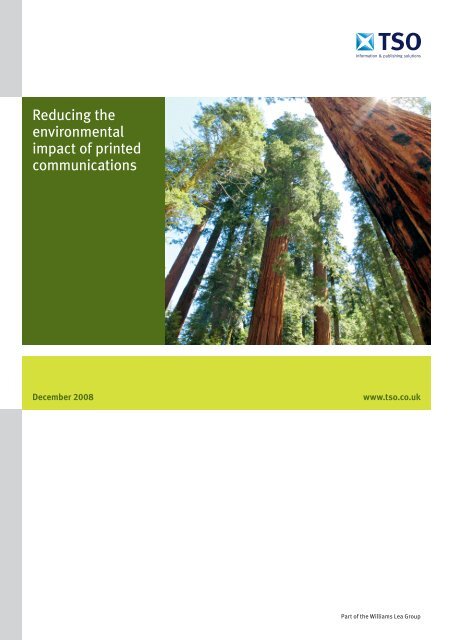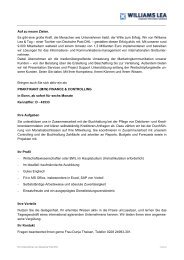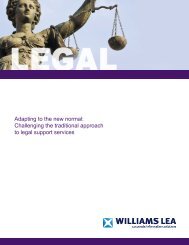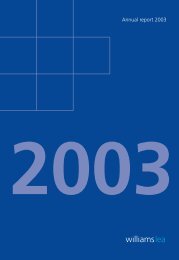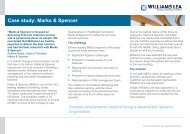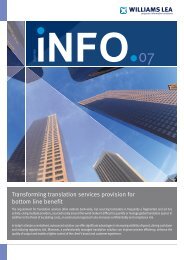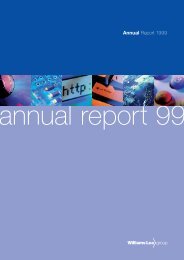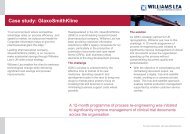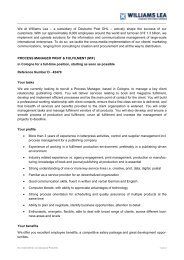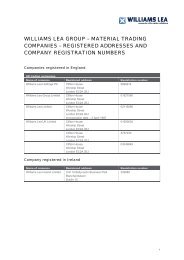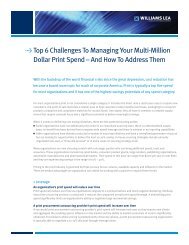Reducing the environmental impact of printed ... - Williams Lea
Reducing the environmental impact of printed ... - Williams Lea
Reducing the environmental impact of printed ... - Williams Lea
Create successful ePaper yourself
Turn your PDF publications into a flip-book with our unique Google optimized e-Paper software.
<strong>Reducing</strong> <strong>the</strong><strong>environmental</strong><strong>impact</strong> <strong>of</strong> <strong>printed</strong>communicationsDecember 2008www.tso.co.ukPart <strong>of</strong> <strong>the</strong> <strong>Williams</strong> <strong>Lea</strong> Group5631 TSO EnviroPaper V0_8.indd 1 5/12/08 10:06:53
<strong>Reducing</strong> <strong>the</strong> <strong>environmental</strong> <strong>impact</strong> <strong>of</strong> <strong>printed</strong> communicationsEnvironmental sustainability is increasingly important for organisations within <strong>the</strong>public and private sectors. Pressure to adopt more sustainable working practicesis mounting in <strong>the</strong> wake <strong>of</strong> government targets and rising levels <strong>of</strong> <strong>environmental</strong>awareness among stakeholders. Paul Buchan, Environment Manager for <strong>the</strong> <strong>Williams</strong><strong>Lea</strong> Group, sets out a roadmap to help you reduce <strong>the</strong> <strong>environmental</strong> <strong>impact</strong> <strong>of</strong> your<strong>printed</strong> communications.By reviewing <strong>the</strong> way your communications are made, <strong>printed</strong> and delivered you canmake significant changes to <strong>the</strong> effects your organisation has on <strong>the</strong> environment.Addressing issues such as <strong>the</strong> type <strong>of</strong> paper used or <strong>the</strong> energy consumed in <strong>the</strong>printing process will improve <strong>the</strong> sustainability <strong>of</strong> your communications withoutaffecting <strong>the</strong> quality <strong>of</strong> <strong>the</strong> service you provide. The changes you make to yourcommunications will also be highly visible to stakeholders, delivering a strongstatement about your commitment to <strong>the</strong> environment.TSO and <strong>Williams</strong> <strong>Lea</strong> have developed an <strong>environmental</strong> roadmap to help you identifyoptions for information and publishing solutions that will benefit <strong>the</strong> environment,your stakeholders and your organisation.The communications life cycleMany organisations have only limited time and resources available to dedicate toissues surrounding <strong>environmental</strong> sustainability, but if used effectively <strong>the</strong>y can stillhave a big <strong>impact</strong>.Firstly, it is essential to ensure you are concentrating your efforts in <strong>the</strong> right place.By identifying which aspects <strong>of</strong> your communications have <strong>the</strong> greatest <strong>impact</strong> on <strong>the</strong>environment, you can channel your resources into making changes in <strong>the</strong> areas where<strong>the</strong>y will make <strong>the</strong> most difference. The Customer Communications Life Cycle will helpyou identify where improvements are most needed.PLANNING DATA DESIGN PRINTING CONSUMPTIONCustomer Communications Life CycleThe <strong>Williams</strong> <strong>Lea</strong> Group’s <strong>environmental</strong> roadmap sets out a framework to help youexplore <strong>the</strong> improvements you can make at each stage <strong>of</strong> <strong>the</strong> life cycle, focusing on:■■ Available options■■ The cost/benefits <strong>of</strong> options■■ Timescales for implementation■■ Environmental metrics for measuring results.Some <strong>of</strong> <strong>the</strong> changes you make may be relatively straightforward ‘quick wins,’while o<strong>the</strong>rs will need careful planning before you can redesign your informationand publishing solutions in a way that meets your requirements while improving<strong>environmental</strong> sustainability.25631 TSO EnviroPaper V0_8.indd 2 5/12/08 10:06:55
Stages <strong>of</strong> <strong>the</strong> CustomerCommunications Life Cycle1. Planning2. Data3. Design4. Printing5. ConsumptionStrategies for each stage <strong>of</strong> <strong>the</strong> life cycleThere are options for increasing <strong>the</strong> sustainability <strong>of</strong> your regular communicationsand one-<strong>of</strong>f campaigns throughout all five stages <strong>of</strong> <strong>the</strong> life cycle from planning toconsumption. Below you will find more information about <strong>the</strong> changes you can make ateach stage:1. PlanningAt <strong>the</strong> planning stage you can:Measure <strong>the</strong> <strong>environmental</strong> <strong>impact</strong> <strong>of</strong> your activitiesThe <strong>impact</strong> <strong>of</strong> your communications on <strong>the</strong> environment can be measured in a variety<strong>of</strong> ways. Research by Trucost identifies <strong>the</strong> three main direct <strong>environmental</strong> <strong>impact</strong>s <strong>of</strong><strong>the</strong> print industry as:1. Greenhouse gases2. Waste3. Volatile organic compound emissions.Greenhouse gas emissions are increasingly used as a measure <strong>of</strong> <strong>environmental</strong><strong>impact</strong>s and form <strong>the</strong> basis <strong>of</strong> government targets such as <strong>the</strong> reduction <strong>of</strong> CO2emissions by 12.5% by 2010. It can also be used as a metric to determine <strong>the</strong> <strong>impact</strong><strong>of</strong> your <strong>printed</strong> communications, but you can use <strong>the</strong> o<strong>the</strong>r methods if you feel <strong>the</strong>y aremore appropriate.Studying <strong>the</strong> greenhouse gas emissions associated with your communicationswill help to identify <strong>the</strong> areas where <strong>the</strong> most significant changes are needed. TSOrecently did this for <strong>the</strong> publications that we produce for a major public sector client.We commissioned The Edinburgh Centre for Carbon Management to investigate<strong>the</strong> emissions associated with each stage <strong>of</strong> production. This revealed areas forimprovement where changes can be made which will lead to significant savings on <strong>the</strong>emissions associated with energy and paper.To help our clients identify <strong>the</strong> greenhouse gas emissions associated with <strong>the</strong>ircommunications, <strong>the</strong> <strong>Williams</strong> <strong>Lea</strong> Group has commissioned <strong>the</strong> development <strong>of</strong> acarbon estimator. This tool is used to assess <strong>the</strong> level <strong>of</strong> emissions associated with<strong>printed</strong> communications before changes are made and <strong>the</strong>n provides ongoing data soour clients can track <strong>the</strong> <strong>impact</strong> <strong>of</strong> <strong>the</strong>ir changes over time. For example after changing<strong>the</strong> type <strong>of</strong> paper used, one client has been able to observe a clear reduction inemissions each year while <strong>the</strong> amount <strong>of</strong> paper used has remained <strong>the</strong> same.Consider alternatives to printYou can also consider alternative communication channels, for example using webbasedor emarketing solutions.There is no definitive pro<strong>of</strong> that digital communications have a smaller carbonfootprint than <strong>printed</strong> information so you will need to evaluate <strong>the</strong> benefits <strong>of</strong> usingdigital channels for each piece <strong>of</strong> information you need to communicate.You may find that certain types <strong>of</strong> information, such as brief updates or messagesdesigned to direct people to a website are best conveyed digitally, while your35631 TSO EnviroPaper V0_8.indd 3 5/12/08 10:06:55
stakeholders may prefer to receive some communications in a <strong>printed</strong> format, forexample <strong>the</strong>y may find long reports easier to read on paper. You will also need toconsider how many users are likely to print out your digital information <strong>the</strong>mselves.The <strong>environmental</strong> costs <strong>of</strong> this may be greater than if you were to print <strong>the</strong> documentscentrally. It is also important to consider that some citizens do not have access todigital channels and any information designed for <strong>the</strong>m will need to be <strong>printed</strong>.2. DataImproved data efficiencyBy using your data more efficiently you can accurately target <strong>the</strong> information yousend, reducing wastage. If you segment your database by lifestyle and behaviouralfactors you can build a pr<strong>of</strong>ile <strong>of</strong> each individual stakeholder, ensuring that you onlysend <strong>the</strong>m relevant information. This will reduce <strong>the</strong> wasted paper and printing usedto send communications to those who do not need <strong>the</strong>m. It is also vital that you keepyour database up-to-date to avoid fur<strong>the</strong>r wastage from sending information to peoplewho have moved or are deceased.You may benefit from using a service such as TSO’s variable data printing solutionif you send transactional information to stakeholders. This will use your segmenteddata to add relevant messages to transactional mailings, eliminating <strong>the</strong> need to sendseparate communications.3. DesignBalancing stakeholder expectations with <strong>environmental</strong> focusCommunications are designed for maximum <strong>impact</strong>, but you can also build<strong>environmental</strong> focus into <strong>the</strong> design process, for example by using recycled or FSCcertified paper or specifying paper sizes that minimise waste in <strong>the</strong> printing process.It is vital to balance <strong>the</strong> quality expected by stakeholders with <strong>the</strong> <strong>environmental</strong>advantages <strong>of</strong> your designs. For example, organisations are <strong>of</strong>ten concerned aboutswitching to recycled paper as <strong>the</strong>y perceive it to be <strong>of</strong> lower quality than <strong>the</strong>ir existingsupply. Your print management supplier may be able to help you source paper whichmeets both your <strong>environmental</strong> and aes<strong>the</strong>tic requirements.TSO and <strong>Williams</strong> <strong>Lea</strong> work with our clients to test papers with varying levels <strong>of</strong>recycled content. This enables <strong>the</strong>m to find a paper which is <strong>of</strong> sufficient quality whilestill having a beneficial <strong>impact</strong> on <strong>the</strong> environment. For one client we sourced a paperwith 50% recycled content. This was <strong>of</strong> a similar quality to <strong>the</strong>ir previous stock andreduced <strong>the</strong> emissions associated with <strong>the</strong>ir communications by over 500 tonnes.45631 TSO EnviroPaper V0_8.indd 4 5/12/08 10:06:56
What is ISO 14001?This international standardrequires printers to meetindependently audited standards.So far, only 6000 organisationshave achieved <strong>the</strong> accreditation.TSO has gained ISO 14001accreditation at our ParliamentaryPress and we are currentlyworking to extend <strong>the</strong> scope<strong>of</strong> <strong>the</strong> certificate to include allTSO locations.4. PrintingThe printing process may be responsible for a significant proportion <strong>of</strong> <strong>the</strong><strong>environmental</strong> <strong>impact</strong>s associated with your communications. The study into<strong>the</strong> production <strong>of</strong> publications for a major public sector client, conducted by TheEdinburgh Centre for Carbon Management on behalf <strong>of</strong> TSO and <strong>Williams</strong> <strong>Lea</strong>,discovered that approximately 30% <strong>of</strong> emissions related to <strong>the</strong>se publications couldbe attributed to <strong>the</strong> printing process.There are a number <strong>of</strong> approaches that you can take at <strong>the</strong> printing stage to reduce <strong>the</strong><strong>impact</strong> <strong>of</strong> your organisation on <strong>the</strong> environment:Suppliers’ <strong>environmental</strong> standardsEnsure that your printers are as <strong>environmental</strong>ly focused as you are. Standards suchas ISO 14001 indicate <strong>the</strong>ir commitment. TSO’s Parliamentary Press has achieved <strong>the</strong>award as have many <strong>of</strong> <strong>the</strong> print companies that make up our supply chain.The <strong>Williams</strong> <strong>Lea</strong> Group can leverage its power as one <strong>of</strong> <strong>the</strong> leading global printpurchasers to ensure <strong>the</strong> <strong>environmental</strong> focus <strong>of</strong> print suppliers. One client with ahighly developed <strong>environmental</strong> focus recognised <strong>the</strong> need to set goals for suppliers.As part <strong>of</strong> our print management solution we increased <strong>the</strong> number <strong>of</strong> ISO 14001accredited suppliers. The percentage <strong>of</strong> <strong>the</strong> client’s print spend going to ISO 14001accredited companies increased from 2% in January 2006 to 75% in September 2007.Stock managementCareful stock management can also yield significant results. By reviewing past printjobs you can estimate <strong>the</strong> potential demand for new publications and reflect thisin your print quantities. This will ensure that you do not print an excess <strong>of</strong> copies,reducing <strong>the</strong> waste <strong>of</strong> paper and energy in producing copies that will not be used, aswell as saving you money on storage costs. You could also consider a Print on Demandsolution to eliminate <strong>the</strong> need to store <strong>printed</strong> copies <strong>of</strong> your publications.A warehousing and distribution solutions provider, such as TSO, will be able to provideyou with regular and detailed management reports which will help you monitor <strong>the</strong>demand for your publications.Print on DemandFor suitable publications you could use a Print on Demand solution, initially producingonly <strong>the</strong> copies you need for <strong>the</strong> launch. Once <strong>the</strong>se copies have been distributedstakeholders can continue to order <strong>the</strong>ir copies in <strong>the</strong> normal way, <strong>the</strong>y are <strong>printed</strong>overnight and dispatched <strong>the</strong> following day instead <strong>of</strong> being retrieved from storage.This ensures that only <strong>the</strong> required number <strong>of</strong> copies are <strong>printed</strong>, eliminating wastageand storage costs while still providing <strong>the</strong> level <strong>of</strong> service that stakeholders require.TSO provides this service for a number <strong>of</strong> high-pr<strong>of</strong>ile public sector organisationshelping <strong>the</strong>m to save money and <strong>the</strong> environment and ensuring that publications canbe updated regularly.55631 TSO EnviroPaper V0_8.indd 5 5/12/08 10:06:56
Find out moreFor more information on howTSO can help you reduce <strong>the</strong><strong>environmental</strong> <strong>impact</strong> <strong>of</strong> your<strong>printed</strong> communications emailinsights@tso.co.uk.To find out more aboutour solutions visit:www.tso.co.uk/solutions5. ConsumptionIt is important that your efforts to reduce <strong>the</strong> <strong>environmental</strong> <strong>impact</strong> <strong>of</strong> your actionsare recognised by citizens and o<strong>the</strong>r stakeholders, as this will raise awareness<strong>of</strong> <strong>environmental</strong> issues as well as your attempts to address <strong>the</strong>m. You could putmessages on <strong>the</strong> publications <strong>the</strong>mselves, for example ‘made from recycled paper,’or use specific logos to show you are complying with certain standards e.g. <strong>the</strong> ForestStewardship Council (FSC) logo which confirms that virgin paper comes from wellmanagedforests.You could also use <strong>of</strong>f-product statements, for example on your website, informingpeople <strong>of</strong> your <strong>environmental</strong> focus. If you have a suppliers’ section on your websiteyou can outline your requirement for print suppliers to have attained ISO 14001 andinclude this in tenders and your sustainable procurement policy.A continual process <strong>of</strong> improvementThere are many ways for you to reduce <strong>the</strong> <strong>environmental</strong> <strong>impact</strong>s <strong>of</strong> your <strong>printed</strong>communications through <strong>the</strong> redesign <strong>of</strong> your information management andpublishing solutions. TSO and <strong>Williams</strong> <strong>Lea</strong> are committed to working with our clientsto develop carefully tailored, sustainable solutions that will ensure <strong>the</strong> quality <strong>of</strong>communications is retained while <strong>the</strong>ir <strong>impact</strong> on <strong>the</strong> environment is reduced.It is important to remember that <strong>the</strong> reduction <strong>of</strong> your organisation’s greenhousegas emissions is an ongoing process. Once you have successfully reduced <strong>the</strong><strong>environmental</strong> <strong>impact</strong>s at one stage <strong>of</strong> <strong>the</strong> communications lifecycle, TSO can helpyou to identify <strong>the</strong> next most significant area for improvement, and develop <strong>the</strong>solutions to help you address it. This will enable you to develop a process <strong>of</strong>continual improvement.CONFIDENTIALITY STATEMENTThe contents <strong>of</strong> this document toge<strong>the</strong>r with all o<strong>the</strong>r information, data, materials, specifications or o<strong>the</strong>r related documents provided by TSO (toge<strong>the</strong>r “materials”) shallbe treated at all times by <strong>the</strong> recipient as <strong>the</strong> confidential and proprietary information <strong>of</strong> TSO. The recipient shall not disclose any such materials to any third parties without<strong>the</strong> express, advance written approval <strong>of</strong> TSO. Where such express approval is granted by TSO, <strong>the</strong> recipient shall ensure that all third parties to whom disclosure is madeshall keep any such materials confidential and shall not disclose <strong>the</strong>m or any part <strong>of</strong> <strong>the</strong>m to any o<strong>the</strong>r person. All intellectual property rights in <strong>the</strong> materials provided byTSO are and shall remain <strong>the</strong> property <strong>of</strong> TSO, or its third party licensors, and are protected by copyright.© 2008 <strong>Williams</strong> <strong>Lea</strong> GroupDISCLAIMERThis document may be incomplete without reference to any oral briefing provided by TSO, reflects current conditions and TSO’s views as <strong>of</strong> this date and is subject tocorrection or change at any time. Although <strong>the</strong> information contained in this document is believed to be accurate in all material respects, nei<strong>the</strong>r TSO nor any <strong>of</strong> TSO’sadvisers, agents, <strong>of</strong>ficers or employees accepts responsibility or liability for or makes any promise, representation, statement or expression <strong>of</strong> opinion or warranty,express or implied, with respect to <strong>the</strong> accuracy or completeness <strong>of</strong> <strong>the</strong> content <strong>of</strong> this document (to <strong>the</strong> extent permissible by law) unless and save to <strong>the</strong> extent that suchpromise, representation, statement or expression <strong>of</strong> opinion or warranty is later expressly incorporated into a legally binding contract.Part <strong>of</strong> <strong>the</strong> <strong>Williams</strong> <strong>Lea</strong> Group5631 TSO EnviroPaper V0_8.indd 6 5/12/08 10:06:57


